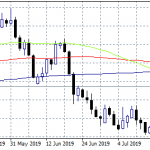- Data from the US, Canada, Euro Zone, Switzerland, and Australia next week could trigger volatility on USDCAD, EURCHF, and AUDUSD.
Next week is the first full week of trading for 2020. There are quite a handful of reports due for release that could trigger potential high-probability trades.
US: ISM Non-Manufacturing, ADP Report, and Non-Farm Payrolls (NFP)
The US will release a roster of high-impact economic data next week. It will begin on Tuesday with the ISM Non-Manufacturing PMI. The forecast is for the report to show that the services sector continued to grow in December with the forecast at 54.4, higher than the baseline reading of 50.0 which indicates expansion. It is also better than the reading for November at 53.9. Market participants will also be looking closely at the employment component of the report.
Speaking of employment, the NFP report will be due on Friday. The figure for December is seen at 168,00 with the unemployment rate eyed at 3.5%. Meanwhile, average hourly earnings is seen at 0.2%. Ahead of the NFP, the ADP report will be released in an effort to predict the official government data. The privately-produced report is estimated to show that 125,000 jobs were generated in December.
Canada: Trade Balance, Ivey PMI, BOC Governor Poloz Speech, and Employment
Canada also has a busy week ahead. It will kick-off its reports on Tuesday with the trade balance report for November. It is expected to show that the value of imports exceeded the value of exports by 985 million CAD. The Ivey PMI will also be released on the same day and the consensus is for the manufacturing sector to have continued its growth in December. The consensus is at 53.8, higher than the 50.0 baseline reading that indicates expansion.
BOC Governor Stephen Poloz is also scheduled to make a speech on Thursday. His optimism on the economy and hints that the central bank will not be easing rates anytime soon could probably be bullish for the Canadian dollar.
Lastly, Canada will release its jobs report at the same time the US will drop the NFP report. Canada is expected to have added 20,700 jobs in December after shedding 71,200 in November. Meanwhile, the unemployment rate is anticipated to tick lower to 5.8% during the month
USDCAD Trade Idea: Trade the Descending Triangle
On the weekly time frame of USDCAD, we can see that the currency pair has been testing support around the 1.3000 psychological handle where it found support on January 27, July 14, and October 27. At the same time, it has been making lower highs. Connecting its most recent lows and highs, a descending triangle chart pattern actually becomes apparent. Worse-than-expected US data or positive Canadian figures could help the currency pair trade lower. On the other hand, if US data tops forecasts or Canadian reports disappoint, USDCAD could pare some of its losses and trade higher.
Read our Best Trading Ideas for 2020.
Euro Zone: Euro Zone Flash CPI Estimate, and ECB Meeting Minutes
Across the Atlantic, the euro zone will release its inflation reports on Tuesday. The euro zone-wide headline figure is eyed at -0.6%. Meanwhile, the core reading which excludes volatile items like energy is estimated to print at -0.1%. Then on Thursday, the ECB will release the minutes of its most recent meeting. If you remember, ECB President Lagarde said in the latest bank statement that they see inflation picking up. She also called on governments to support the region’s financial system through fiscal stimulus.
Switzerland: CPI, Retail Sales, and Unemployment Rate
It’s not every week that we get data out of Switzerland and so, next week may be a good idea to keep tabs on CHF pairs. On Tuesday, the CPI report for December is expected to print at -0.3%. It will then release its retail sales report on Thursday with the consensus at 0.4%. Finally, on Friday, the country’s unemployment rate for December is eyed at 2.3%.
EURCHF: Will Support at 2019 Lows Hold?
On the weekly chart of EURCHF, we can see that the currency pair tested its 2019 lows for support at 1.0840. Negative euro zone data or dovish ECB meeting minutes could trigger a bigger sell-off next week and push the currency pair even lower to its 2017 lows at 1.0640. On the other hand, if data from Switzerland disappoint, it could force the SNB to warn against further easing and help EURCHF find bids in the market.
Australia: Building Approvals, Trade Balance, and Retail Sales
Australia will also have its fair share of economic reports next week. The first one on its list is the building approvals report for November. It is expected to show a 4.7% uptick in approvals. Then on Thursday, the trade balance report for the same month is anticipated to show that the value of exports were 5.915 billion AUD more than imports. Lastly, on Friday, the retail sales report is expected to show that consumer spending grew by 0.2% in November
AUDUSD: Potential Fibonacci Play
On the daily time frame, we can see that the uptrend on AUDUSD is still intact. Connecting the lows of November 29, December 10, and December 19, the trend line support falls around 0.6910. This price also coincides with the 61.8% Fib level when you draw from the low of December 18 to the high of December 31. On top of that, AUDUSD also found resistance at this price in the past. Reversal candles around this area could mean that the currency pair will resume its upward rally.





